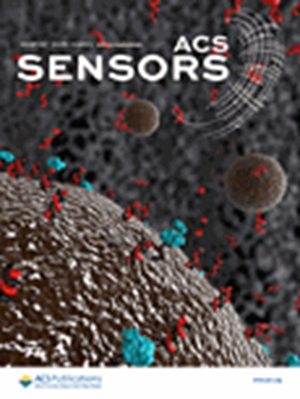λ θ反射法:一种测量平面蛋白质阵列光学膜厚度的新技术。
IF 9.1
1区 化学
Q1 CHEMISTRY, ANALYTICAL
引用次数: 0
摘要
定量蛋白质测量提供了有关生物途径、免疫系统功能和疾病机制的宝贵信息。最准确的检测蛋白质的方法是无标记和保留天然蛋白质结合相互作用。无标记生物分子相互作用分析包括反射法,这是一组通过测量衬底上薄膜的反射特性来检测蛋白质的技术。大多数这些技术在某种程度上受到仪器复杂性、灵敏度或耗材制造要求的限制。为了解决这些问题,我们引入了Lambda Theta反射法(LTR),这是一种新的反射法技术,通过确定零反射率点作为波长(Lambda)和入射角(Theta)的函数来测量薄膜厚度的变化。衬底同时被一系列角度和波长照射,反射光从角度和光谱上都被分辨出来。我们的原型LTR反射计可以以毫-Ångström精度测量SiO2层厚度。Si/SiO2氧化膜的LTR测量结果与光谱椭偏测量结果非常吻合,膜厚度范围为1390至1465 Å。该技术能够在生物分析物浓度范围内(0.5 ng/mL至μg/mL)进行无标记生物传感测量,而无需严格控制探针沉积厚度或衬底制造。本文章由计算机程序翻译,如有差异,请以英文原文为准。
Lambda Theta Reflectometry: A New Technique for Measuring Optical Film Thickness in Planar Protein Arrays.
Quantitative protein measurements provide valuable information about biological pathways, immune system functionality, and the mechanisms of disease. The most accurate methods for detecting proteins are label-free and preserve native protein-binding interactions. Label-free biomolecular interaction analysis includes reflectometry, a group of techniques that detect proteins by measuring the reflectance properties of a thin film on a substrate. Most of these techniques are limited in some way by instrument complexity, sensitivity, or consumable manufacturing requirements. To address these issues, we introduce Lambda Theta Reflectometry (LTR), a new reflectometric technique that measures changes in film thickness by determining the point of null reflectivity as a function of wavelength (lambda) and angle of incidence (theta). The substrate is simultaneously illuminated with a range of angles and wavelengths, and reflected light is resolved both angularly and spectrally. Our prototype LTR reflectometer can measure SiO2 layer thickness with milli-Ångström precision. LTR measurements of Si/SiO2 oxide films are in excellent agreement with spectroscopic ellipsometry for film thicknesses ranging from 1390 to 1465 Å. This technique enables label-free biosensing measurements across a range of biological analyte concentrations (0.5 ng/mL to μg/mL) without requiring stringent control over probe deposition thickness or substrate manufacturing.
求助全文
通过发布文献求助,成功后即可免费获取论文全文。
去求助
来源期刊

ACS Sensors
Chemical Engineering-Bioengineering
CiteScore
14.50
自引率
3.40%
发文量
372
期刊介绍:
ACS Sensors is a peer-reviewed research journal that focuses on the dissemination of new and original knowledge in the field of sensor science, particularly those that selectively sense chemical or biological species or processes. The journal covers a broad range of topics, including but not limited to biosensors, chemical sensors, gas sensors, intracellular sensors, single molecule sensors, cell chips, and microfluidic devices. It aims to publish articles that address conceptual advances in sensing technology applicable to various types of analytes or application papers that report on the use of existing sensing concepts in new ways or for new analytes.
 求助内容:
求助内容: 应助结果提醒方式:
应助结果提醒方式:


